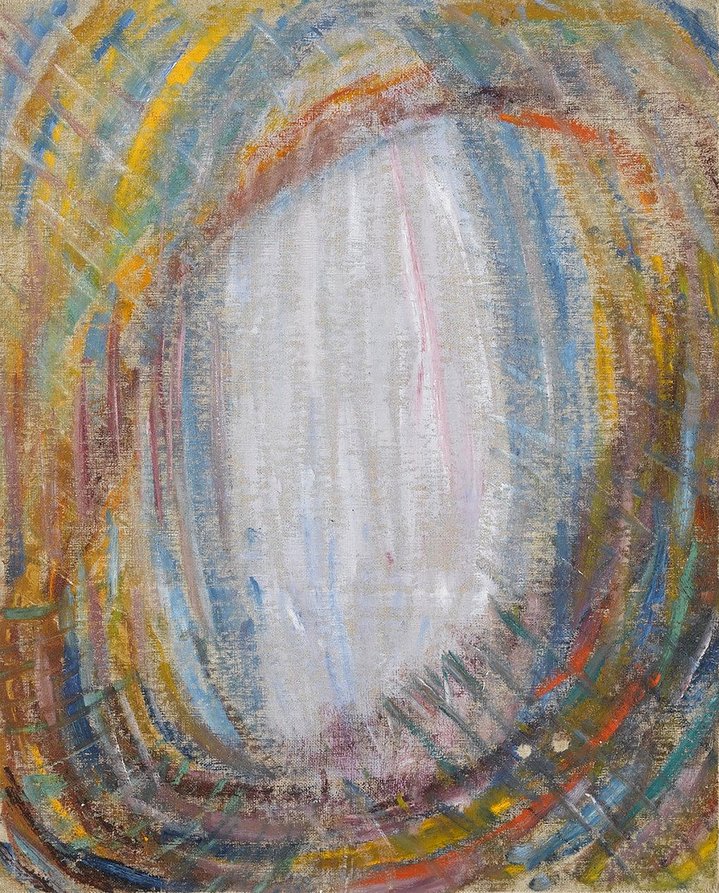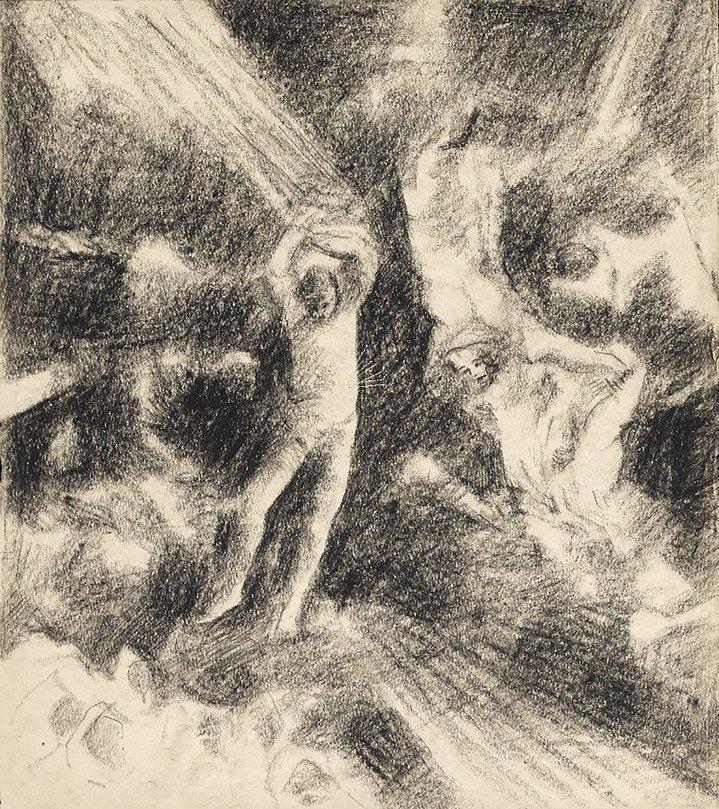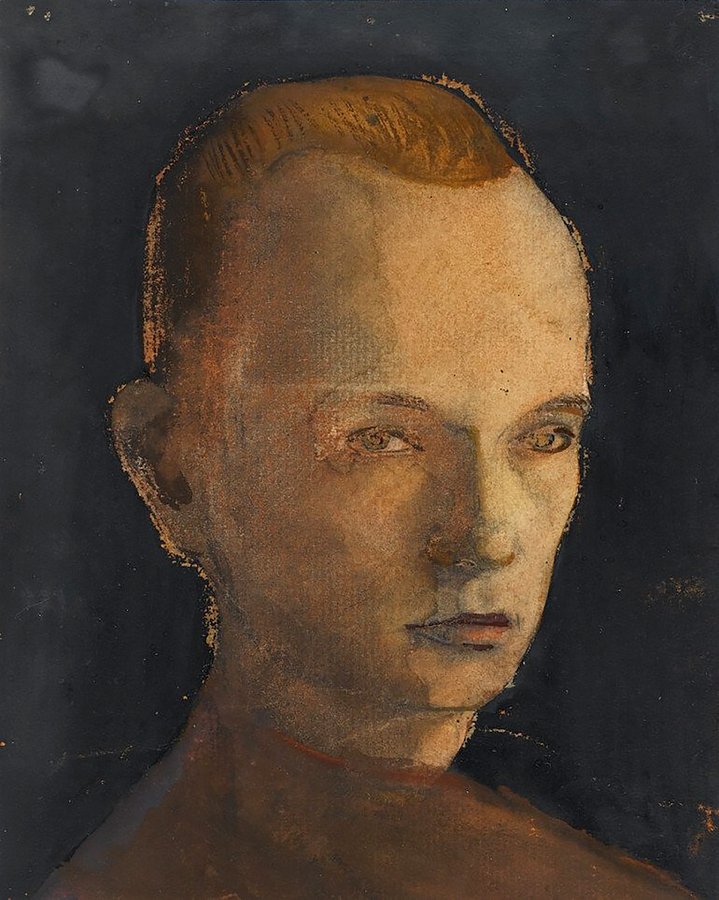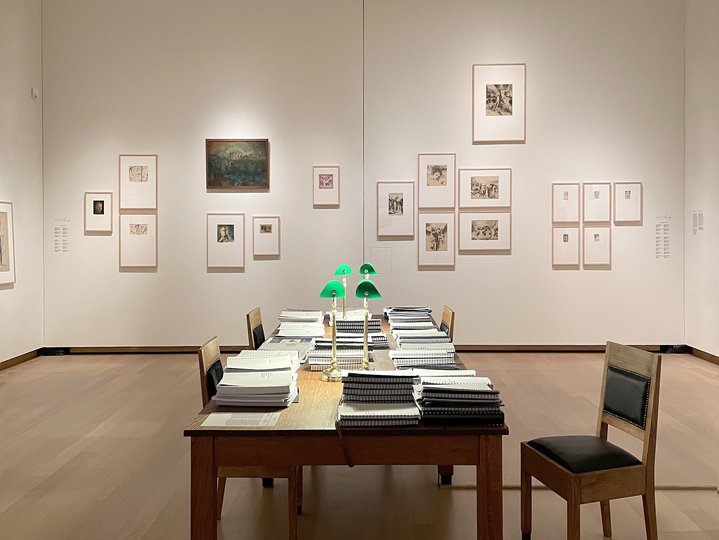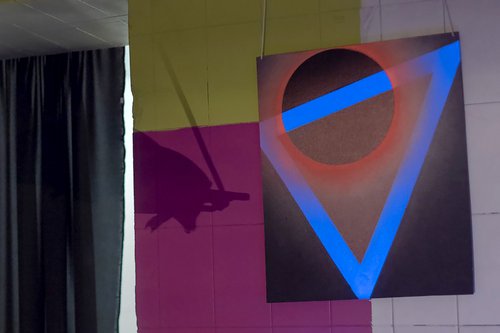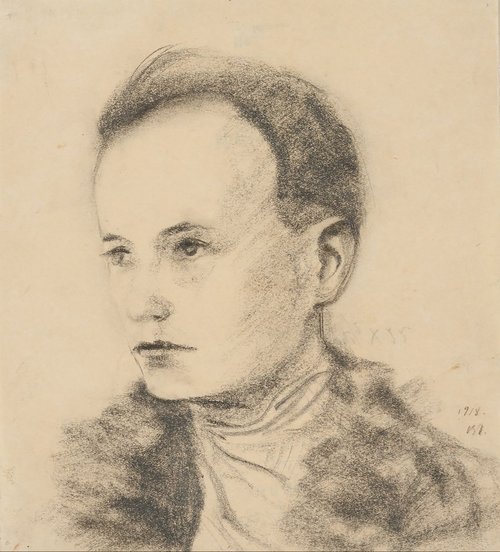Natalia Goncharova. Rayonist Sea, 1912–1913. On loan Stichting Khardzhiev. Courtesy of Stedelijk Museum
The exhibition ´Cosmism. Images from a Future Gathering´ at Amsterdam’s Stedelijk Museum explains how utopian visions of Russian philosopher Nikolai Fyodorov have resonated in art from the 1910s to the present day.
In a spacious ´white cube´ in the foyer of the Stedelijk Museum, viewers are greeted with an installation of lightboxes which shimmer mysteriously, where grainy black and white photographs show an endless starry sky and there is a man establishing a connection with the celestial bodies using a kind of laser beam. Kazakhstan, where the famous Baikonur space-launch site is located, is a real portal into space, and often the subject of works by Central Asian artists. The 2009 series ´Lord of the Stars´ by the Almaty based duo Elena (b. 1959) and Viktor (b. 1959) Vorobyev was inspired by an unfinished sci-fi novel Ástral Nomads´ by their artist friend Sergey Maslov (b. 1952) and is about adventures in space of contemporary Kazakh artists, where the artist duo is among the characters. This installation is a prologue to the exhibition ´Cosmism. Images from a Future Gathering´, which occupies one of the rooms in the enfilade, where there is a permanent exhibition of early 20th century art, including a collection of works by Kazimir Malevich (1879-1935), considered to be one of the gems of the museum.
The exhibition is based on the fabled art collection of Russian art historian and writer Nikolai Khardzhiev with the inclusion of some of the museum´s new contemporary acquisitions and becomes a kind of key, a contextual field, an extended commentary on the permanent exhibition, which includes almost all avant-garde trends, the main elements of which were often utopian ideas of creating a new kind of human being, striving for progress, a bright future and the cosmos.
The starting point and the project's tuning fork are the theories of Russian philosopher Nikolai Fyodorov and his followers, in particular the notions around achieving immortality through the development of new technologies and science, the possibility of resurrecting the dead, and the exploration of space and other planets in connection with the overpopulation of the Earth as a result of victory over death. For curators Frank van Lamoen and Robbie Schweiger, the exhibition is a "condensed journey" through utopias and dystopias inspired by cosmism.
At the centre of the exhibition is a body of works by Vasily Chekrygin (1897–1922), an idiosyncratic artist who dedicated his work to the Fyodorovian idea of overcoming death, yet himself tragically dying at the age of 25. Chekrygin worked alongside David Burliuk (1882-1967), Kazimir Malevich, Mikhail Larionov (1881–1964), Natalia Goncharova (1881-1962), Vladimir Tatlin (1885–1953) and other avant-garde artists, was at the front and saw firsthand the horrors of the First World War. At the end of 1920 he began a large series of works on paper, similar to mystical visions, which was to be a project for a fresco. The main theme is the resurrection of the dead, depicted as floating, rising and falling human figures wrapped in shrouds, an ´exodus from chaos into cosmos´, artists resurrecting their fathers, a literal illustration of Fyodorov's ideas. One of the gems of the exhibition is a rare pictorial ´Self-Portrait´ of the artist from 1918-1920 from the collection of Nikolai Khardzhiev.
The neighbouring wall presents Kazimir Malevich's universe, from his early Symbolist works to stage design and costume sketches for the famous 1913 opera ´Victory over the Sun´. His collaboration on the futurist opera with poet Aleksei Kruchenykh (1886-1968) and artist Mikhail Matyushin (1881-1934) was a key event that led to the birth of a new radical art form called Suprematism. Another masterpiece from Khardzhiev's collection is shown here: ´Suprematist Spirit´, a nuanced painting on wood, superimposed lines in the form of a cross with a white square in the middle.
Elsewhere, on the wall opposite, as a kind of counterpoint to Malevich's geometric abstraction, is a group of works that can be conventionally classified as belonging to the ´organic´ movement, where each artist echoes cosmist ideas about universality. The Rayonnism of Natalia Goncharova and Mikhail Larionov was one of the first abstract movements, where the contours of objects were outlined by the intersection of rays, linking by invisible threads all animate and inanimate things. Mikhail Matyushin developed the theory of ´zorveda´, the expansion of sensory perception and the angle of vision up to 360 degrees, and he considered the surrounding space as a sphere where everything is interconnected. Pavel Filonov (1883-1941) came to the concept of ´world flourishing´, where each point or dot in a painting was considered by him as a ´unit of action´, and each painting and drawing was painstakingly built up as in nature a whole is formed from cells and atoms. Ivan Leonidov's (1902-1959) expressive sketches for ´City of the Sun´ (1947-1959), one of the most famous utopian projects of the 20th century, complete this series.
A special place in the exhibition is occupied by the works of Feodosiy (Theodor) Tetyanich (1942-2007), which are new acquisitions at the Stedelijk. Tetyanich, a colourful figures of Ukrainian art of the 1960s-1980s, started out as a muralist and invented Freepulia, his own universe, which existed in parallel with mundane official art, and eventually supplanted state commissions in the artist's practice.
Tetyanich's immense artistic system, Freepulia is difficult to describe. Its main elements were the aspiration to reach and engage with the cosmos, infinity, and the inseparability of the process of life and art, where even the simplest and most absurd action or object could be categorized as aesthetic. Freepulia even became the motto, mythology and pseudonym of the artist himself, who described it as a form of energy, radiation or biofield containing the entire essence of man. Tetyanich was the first Ukrainian artist to introduce actions and happening into his artistic practice. He dressed up in brightly coloured fabrics and foil, wore improvised headdresses made from used boxes, collected mountains of rubbish and scrap metal and staged actions in the streets of Kyiv, where random sounds such as rumbling, ringing and clanging were combined with unusual actions and often the involvement of an otherwise unsuspecting public.
One of the main projects that brought Tetyanich's art closer to the architectural utopias of Malevich and Leonidov were ´biotechnospheres´, spherical architectural structures for one or two people, capable of supporting eternal life and equipped with everything necessary, located around a central zone. These autonomous capsules could be folded into modules and envisaged the possibility of travelling on Earth and in space without leaving home, but by moving the spheres with the help of flight vehicles. In 1984, the prototype of such a biotechnosphere, assembled from improvised materials, was installed as a decoration for a bus stop, later dismantled.
A beautiful final chord – and yet perhaps also another starting point - is an interactive installation by Anton Vidokle (b. 1965), the main adherent of cosmism who researched its influence on contemporary art and culture in post-Soviet countries. ´Cosmist Reading Room´ (2020-present), is a reconstruction of elements from a typical Soviet library with simple chairs and a table with green lamps. Visitors to the exhibition are invited to sit down and immerse themselves in the writings of philosophers - compendiums, articles, reflections, interviews and studies on cosmism by Fyodorov and Konstantin Tsiolkovsky to Walter Benjamin, Boris Groys and Arseny Zhilyaev, which Anton Vidokle systematically collects and translates into English.
Vidokle's installation and his idea of researching and searching for traces of cosmism in the post-Soviet space is in alignment with the curatorial vision as a whole. Despite some fragmentation and limitations on the selection of works, the curators felt free to create interesting juxtapositions as well as make a fully-fledged statement, and the result is a subtle, complex and unusually informative exhibition which presents cosmism as one of the main lines which runs through both modernism and contemporary art. The only drawback of the exhibition are the works which are literally floating in space, a drawing by Chekrygin and paintings by Malevich. Although hanging them far above eye level is a fun trick, it deprives viewers of the opportunity to examine these fascinating works up close.
Cosmism. Images from a Future Gathering
Amsterdam, The Netherlands
13 January – 3 March 2024






